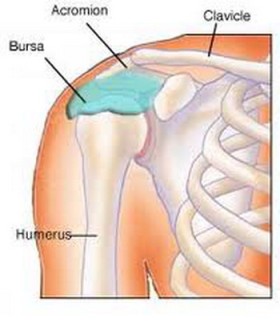
shoulder-bursitis
The bursa in the shoulder is located in-between the four muscles that make up the rotator cuff and the arch of the subacromial space, providing it with its name, subacromial bursa.
Bursitis is an inflammation of a bursa caused by injury or less commonly, infection. Shoulder bursitis is caused by repeated overhead movements causing the bursa to be squashed or impinged between the muscles and bones.
A short spell of sport, where overhead movement is involved i.e. volleyball, when you are not used to it can cause bursitis.
Symptoms can come on gradually or be instantaneous.
Localised pain or swelling, tenderness and pain with motion of the joint will indicate that you have a problem. Pain will be located at the tip of the shoulder and can radiate down the arm. You will not be able to raise your arm over your head. Pain can become worse if you lie on the affected side at night.
Diagnosis will be made by your G.P. or physiotherapist. An x-ray or MRI may be needed for diagnosis, to rule out other causes of the pain i.e. rotator cuff tear.
Treatment will depend on how far the bursa has developed. If it has just started, physical therapy can cause improvement. Ice therapy will be recommended by your physiotherapist, for 20 minutes every few hours. Never put ice directly on the skin, always wrap in a towel. This will reduce pain and inflammation along with resting the joint. Anti-inflammatory medication will help with the pain, under the supervision of your G.P.
A physiotherapist will then give you exercises to restore range of movement and increase muscle strength and stability. These may begin quite gently as pain allows but will build up to resistance exercises using a resistance band.
Occasionally these treatments will not reduce your bursa and a doctor will be required to drain it with a syringe in sterile conditions. You will then begin your physiotherapy as explained above.